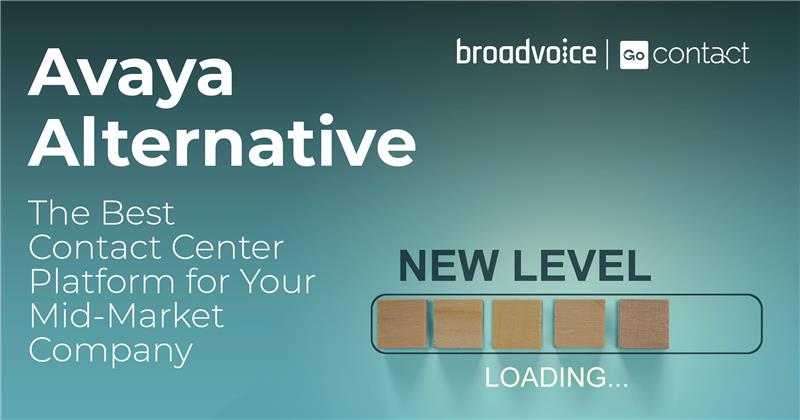Imagine you’ve spent years fine-tuning your contact center platforms. Your agents know the systems, and your managers can train on them. Your customers understand it. And IT runs them like a well-oiled machine. And then, seemingly overnight, Avaya tells you that unless you have 200 seats or more, they can’t help you anymore. Sounds terrifying, right?
That’s exactly what’s happening.
By June 2025, Avaya will enforce a monthly minimum commitment of 200 seats. That means customers with fewer than 200 seats must find an Avaya alternative or risk losing access to their critical communications infrastructure. The good news is that you can cancel without penalty if you’re impacted. The bad news? That still leaves you scrambling to find a new solution that meets your operational needs without breaking the bank.
The bottom line? Avaya is moving on from mid-market contact centers. But you don’t have to be left behind.
The Changing Landscape of Contact Center Platforms
If you’re feeling frustrated (or downright furious), you’re not alone. Hundreds of mid-market companies are now facing an urgent decision. And knowing 32% of customers say they’ll stop doing business with a brand they love after just one bad experience, the pressure is real.
The contact center industry has, for years, been shifting towards cloud-based solutions, AI automation, and omnichannel support, but this Avaya shakeup forces mid-market players to rethink their entire strategy. So, what are your competitors doing in 2025?
- Ditching outdated systems in favor of flexible cloud-based platforms
- Using AI to make agents faster, smarter, and more consistent in their service quality
- Moving fast to avoid last-minute disruptions
With Avaya pulling the plug, the smartest mid-market contact centers are already lining up their next-gen platforms. Are you?
Understanding Your Options: What You Need in an Avaya Alternative
Not all contact center platforms are created equal. Some are hyper-focused on enterprise customers, and others dabble with servicing smaller centers. While still others (*cough* like us *cough*) were built specifically for the mid-market.
To avoid jumping from one frustrating system to another, here’s a list of what actually matters.
5 Must-Haves When Choosing an Avaya Alternative
1. Scalability and AI-Powered Automation
Your contact center isn’t static. It needs room to evolve as your business grows and flexes. The right platform should scale effortlessly to add or remove seats without hitting arbitrary thresholds or adding to your IT department’s never-ending to-do list.
Beyond basic scalability, a modern platform should also use AI-driven functionality like advanced IVRs, call summaries, and sentiment analysis. It should also include chatbots and robust analytics that will help you measure and optimize your team’s productivity and customer satisfaction. These features help your agents work smarter, reduce handle times, and deliver personalized customer interactions at scale.
See how Broadvoice uses AI to improve the agent and customer experience.
2. Security and Compliance
Data security isn’t just a checkbox on your RFP. It can absolutely be a dealbreaker. Any Avaya alternative you evaluate should meet industry standards like HIPAA, GDPR, and SOC2 to protect sensitive customer data. Fraud prevention, real-time threat detection, and built-in encryption are also non-negotiables. Without them, you’re exposing your business to compliance risks, fines, and potential breaches. Yikes!
3. Seamless Integrations
Your contact center can’t operate in a vacuum. So, make sure the platforms you consider can connect with your existing tech stack. The best solutions come with pre-built integrations and open AIPs for your CRM, workforce management (WFM), and helpdesk platforms. The last thing you need is a system that forces agents to toggle between screens to get customer history, call history, and product information. This only slows them down and frustrates your customers.
4. Cost-Effectiveness
Cost is always a major factor (obviously). But it’s not just about the sticker price. While evaluating platforms, take a look at the pricing structure. Are you paying for what you need, not just for an arbitrary seat minimum? Is the pricing transparent and all-inclusive? Are you required to pay for features you’re not going to use? Or are you getting nickel and dimed to add features you do need? In your list of non-negotiables, make sure to include logical, transparent pricing.
5. Cloud Flexibility
Can your agents work from anywhere without issue? A cloud-based solution ensures your agents can work wherever they are, with real-time access to customer data, omnichannel communication tools, and AI-driven insights. A truly flexible platform lets you scale your workforce up or down, whether you’re expanding your team or adjusting for seasonal demand
Making the Move: A Practical Roadmap for Avaya Customers
We get it—switching platforms is painful and overwhelming. But with a clear plan in place and the right partner, the transition can be smooth and even beneficial. The key is to take a strategic approach. Look at your current challenges, engage the right stakeholders, and carefully choose your next platform.
The worst thing you can do? Wait until the last minute. With Avaya pulling support for mid-market customers by this summer, you can’t afford to wait.
This four-step roadmap will help you navigate the transition, ensuring you find an Avaya alternative that meets your operational needs without causing unnecessary disruptions.
1. Assess Your Contact Center Needs and Pain Point
- Where is your current platform falling short for your team?
- What do your agents, supervisors, and IT teams actually need to do their jobs?
2. Build a Transition Plan (and Include Your Key Stakeholders)
- Engage your key decision-makers now. And then document roles and responsibilities so everyone is aligned.
- Create a realistic migration timeline with testing, onboarding, and contingency plans.
3. Vet Potential Platforms
- Ask about pricing transparency, contract terms, and hidden fees.
- Look at your vendor’s history with the mid-market to ensure they have experience and stability.
- Demand clear answers on uptime, support availability, and training.
4. Execute the migration
- Follow a structured rollout plan to keep downtime to a minimum.
- Train key staff first, then deploy the platform in phases for smooth adoption.
Feature Spotlight: Broadvoice | GoContact—Your Avaya Alternative
So, what’s next after Avaya? Meet Broadvoice.
We’re a CX platform specializing in contact center and unified communications. Our product is built specifically for mid-market contact centers and offers a seamless, AI-powered platform with no seat minimums and rapid migration support.
With Broadvoice, you get:
- No-risk migration with a 90-day onboarding and transition plan
- A customer support manager assigned to you for the life of your contract
- Simple, transparent pricing with no hidden costs
- Guaranteed reliability and a geo-redundant architecture
- Robust reporting and actionable analytics
Switching platforms might not have been your choice, but choosing the right provider definitely is.
By choosing the right contact center platform, you can future-proof your operations, increase efficiency, and deliver the kind of customer experience that sets you apart.











